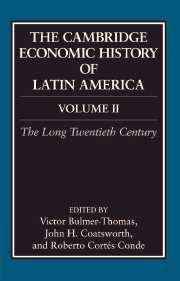Introduction
Published online by Cambridge University Press: 28 March 2008
Summary
In the past two decades, new research has transformed the economic history of Latin America. The pioneering work of the structuralist and dependency school historians, often collaborating with the United Nations Economic Commission for Latin America and the Caribbean (ECLAC), produced a huge outpouring of new economic data in the 1950s and the 1960s, including the first historical (and in some cases current) estimates of Gross Domestic Product (GDP) for a number of countries. Statistical agencies and central banks, often founded and staffed by ECLAC graduates, undertook further work. The search for economic historical data was also stimulated by historians trained in the Anglo-American empirical tradition and in the methods of the French Annales School, and by heterodox development economists schooled in England and the United States. In the 1970s, these currents were joined by historians and economists trained mainly in the United States and often associated with the New Economic History. The ensuing debates over approaches and paradigms were fueled by the shifting fortunes of competing economic strategies – socialism, import substitution, freer trade – and by the rise of repressive military regimes throughout much of Latin America.
Latin America’s economic history took a decisive turn with the 1982 financial and economic crisis and the ensuing transition to democracy throughout the region. Theoretical debates over competing economic strategies diminished in intensity. As democracies consolidated and the Cold War ended, ideological conflicts subsided or became muted. Economic history, like the social sciences in general, professionalized in an environment that demanded better data and more sophisticated and coherent arguments.
- Type
- Chapter
- Information
- The Cambridge Economic History of Latin America , pp. 1 - 8Publisher: Cambridge University PressPrint publication year: 2006
- 1
- Cited by



